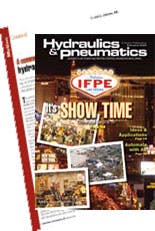I just received my February issue of H&P and always look forward to reading it every month. I had to write concerning Jack Johnson’s article on page 24. Although I am certain Jack is quite knowledgeable in many areas, he is off base on this particular subject. He starts by stating that the idea of pumps creating flow, not pressure, is a “myth.”
His article is mind expanding, but inaccurate. This article could be quite confusing to a newcomer in the industry. I am not a P.E. but have been troubleshooting systems (crawling power units) for more than twenty years. If a newbie takes his initial statement at the top of the first page to heart, it will lead him down the wrong path — at least in terms of troubleshooting existing systems.
The statement that “pumps produce flow” is followed by the words “not pressure.” Experioenced people know this is theoretical,and we know that there are restrictions built into systems that produce an inherent amount of pressure. It seems as though we are splitting hairs here. If you start up a pump and vent it to atmosphere, it will not produce any noticeable pressure when compared to the system operating pressure, but it will produce flow. End of statement.
One of the biggest hurdles I have had to overcome as a manager or mentor is helping our technicians understand that pumps do produce flow, pressure. This seems to be one of the hardest concepts for people to comprehend when entering this field. Some people who have been with me for more than a year are still not 100% convinced that this is accurate. They will look at you like a monkey doing a math problem when you try to teach them this concept.
In the article, Jack really never “busts the myth”(makes a clear argument that the statement is incorrect), unless I missed the point somewhere. It left me hanging for his answer.
Please understand that I am not trying to be argumentive. I just feel that the article is confusing and wrong in its underlying assumption. I pass my magazine on to my hydraulic technicians after I have finished with it. If I am asked about this article, as happens frequently, I am not sure what answer I can give my guys. They expect me to have all the answers.
It would be beneficial to have others read the articles prior to publication for a second opinion and feedback. I well know that we are all not perfect. I am challenged with knowledge every day when I come to my job. I thank you for your time.
Butch Castleberry CCC Group, Inc. Heavy Hydraulic Div. manager [email protected]
Jack Johnson responds:
Thank you for reading the Motion Control article and thank you for your thoughtful reply.
You make an assertion that the article is “inaccurate” and “confusing” and “wrong.” I, too, prefer not to be argumentive. However, I must emphatically assert that the article is correct. The positions taken by ISO and NFPA in their definitions are the correct ones; that is, pumps convert mechanical energy (power) into hydraulic energy (power). This is my position as well.
You have made my point for me in your statement that the article is “mind expanding.” That, precisely, is what I am trying to do. And I think viewing pumps as flow producers — rather than energy converters — severely restricts the insight necessary to understand the entire burgeoning gamut of applications that use servo and proportional valves to control motion. This, I further assert, is the future of hydraulic technology.
The NFPA has seen fit to embark upon an effort to produce standardized, energy conversion-based mathematical models of hydraulic pumps and motors. The various models were introduced very briefly in the article. These new models will be enormously helpful in teaching all aspects of pumping technology and applying hydraulic pumps to the many end uses to which they are put, both pressurecompensated and positive displacement applications.
In your own work you prefer to teach the positive displacement principle as the fundamental function of a pump, and in my first paragraph, I explain the rationale behind it. I encourage you to continue to use it in your work, especially if your applications never make use of servo or proportional valves. If it works for you, you have an obligation to use it. Let me not interfere.
In contrast, it has been my experience in teaching the design methodology of electrohydraulic motion control, which makes broad use of servo and proportional valves with pressure compensated pumps, that the positive-displacement principle is an encumbrance. It is my further experience that those system designers who come to the electrohydraulic motion control technology via the “positive displacement as first principle” education are the most difficult to convert to motion control thinking. Had they been taught that pumps convert energy, it would be easier to expand intellectually into an area that leads into the future.
You close off your letter by urging the editors “to have others read the articles prior to publication for a second opinion and feedback.” Let me assure you that professional editors at Hydraulics & Pneumatics do indeed read all my work, and if I write something that is “wrong” or “inaccurate,” they will demand a defense of my assertions and a rewrite if there are errors. As for feedback, you have provided it with your letter, and I thank you, most sincerely, for taking the time and making the effort to provide it.
On the issue that the article is “confusing,” shame on me for that. I will certainly try in future issues to offer greater clarity, and I extend to you, my most sincere apologies. Writing confusing stuff is beneath my own personal standards. I pledge to you to try harder.
Future articles in the “Myths Series” will expound on the challenges inherent in servo, proportional electrohydraulic motion control. I urge you to continue reading, and if you take issue with what I write, encourage you to write again.


